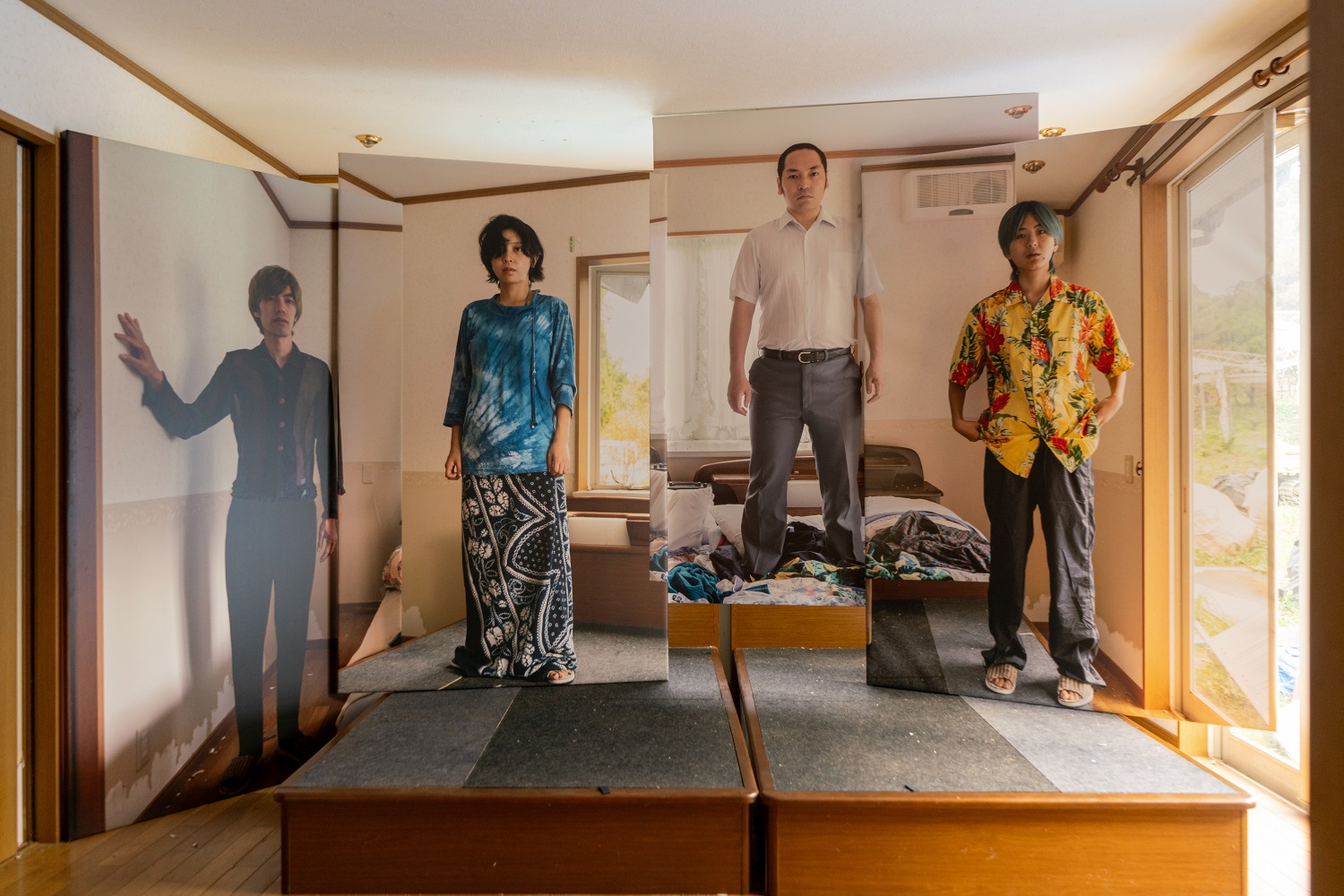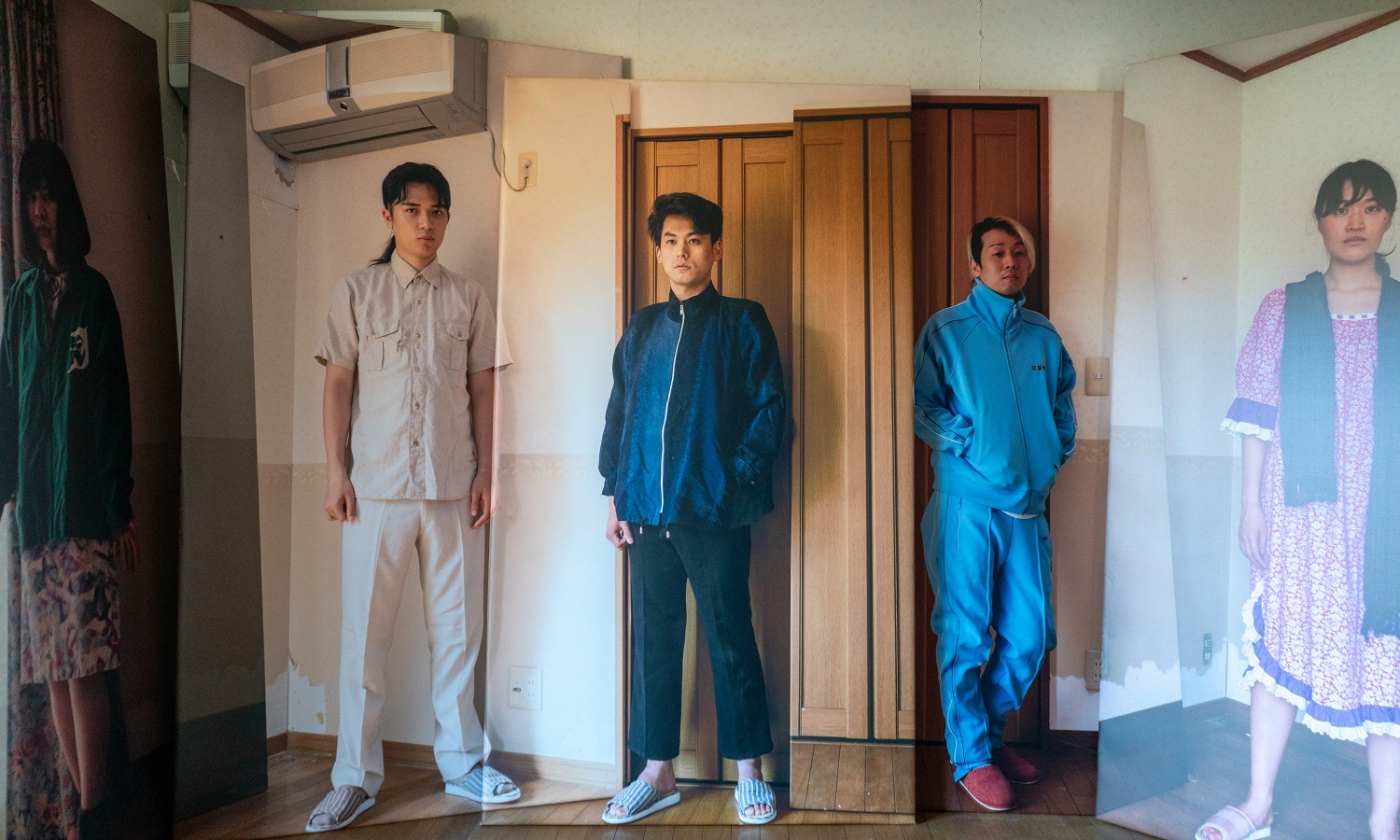About a work for Don't Follow the Wind
There are lots of everyday clothes left on houses in the exclusion zone of nuclear disaster.
The clothes separated from owners. Somebody ever wore them and somebody may wear them sometime.
I wore such clothes in a room and took a self-portrait with my friend, and installed the life-size printed photo on the room.
When does somebody who will encounter with the photo think our clothes should be worn?
A person who wear the cumbrous protective clothing may regard us as light equipments in the future when decontamination of the whole area was finished.
A person who eats and drinks with short sleeves may regard as a nostalgia to the past before the accident.
The photo infront of visitor do back and forth between the future and the past, in this "socially ambiguous place".
When time passed, and entrance restrictions were canceled, and nobody most felt the need of the protective suit,
The photo will finish its timetravel and be a normal souvenir picture. (2015)
異なる立場・考えの人とどう協同できるか、このプロジェクトに関わるようになってからいつも頭を悩ませている。顔も見えない相手を言い負かせばそれで済むということは、現実社会では少ない。
私は放射性物質の付着を気にする人に、靴カバーについたゴミを車内に入れないように脱ぐ方法を注意深く教えた。しかし別の日に同じ場所で、半そで半パンでおにぎりをほお張って談笑している。
衣服・ふるまいの政治性がこれほど強調される場はない。
原子力災害による立入制限区域内の住宅には災害時から部屋に残されたままの服がある。持ち主から引き離された服は、かつて誰かが着た服であり、いつか誰かが着る服でもあろうか。
私はある部屋に置き去りにされた服を着て同行者と写真を撮影し、その写真を部屋に置いてきた。これから写真と出会う人は我々の服装をいつのものと見なすだろうか。
防護服とマスクをガチガチに着込んだ人が、区域全体が除染された後(未来)に着るべき時期尚早の服装と見なすかもしれない。防護を必要とせず半袖で飲食しながら訪れた人が、事故以前(過去)への憧憬と見るかもしれない。
この"社会的に曖昧な場所"で、訪問者を前にして写真は過去と未来を行ったり来たりする。
時間が経って立入制限が解除され、ほとんど誰も防護服を着る必要性を感じなくなった時に、写真は時間旅行を終え何の変哲も無い記念写真になれるだろう。(2015)


Time travelers / 2015- / photoinstallation (inkjet on tarpaulin sheet)in a room in the exclution zone in Fukushima
タイムトラベラーズ / 2015- / 写真インスタレーション(ターポリンにインクジェット)、福島県の帰還困難区域のとある部屋にて
Time Travelers
Text by Kota Takeuchi
Edited by Jason Waite
This photo installation, entitled Time Travelers, is my contribution to Don't Follow the Wind, informed by my experience as a former clean up worker in the Fukushima exclusion zone and spending time in the area as I continue to live in the prefecture of Fukushima and am a local participating artist in the exhibition.
The project focuses on the politics of clothes in the zone. In May 2011, two months after the nuclear disaster at the Fukushima Dai-ichi Nuclear Power Plant owned by TEPCO, local residents who had all been evacuated were allowed temporary access to the zone for a few hours at a time to visit their homes and gather certain belongings. When entering the zone the local government mandated the residents protect their bodies by wearing disposable coveralls the government provided. While face masks stop particles from entering the body, these suits do not prevent radioactive exposure but rather they prevent many of the radioactive particles landing on the suit from leaving the zone, as the coveralls are collected and burned after they are worn. In June 2011, the Japanese government announced that wearing protection suits in the zone was not strictly compulsory and entrusted individuals to decide how they would like to protect themselves. Actually there are many different types of protection clothing worn in the zone depending on where one visits, what type of work one does, the weather, temperature, and depending on an individual's perception about the potential effects radiation.
You also may be wearing coveralls now. Or you may be wearing everyday clothes now.
On trips where I have accompanied former residents into the zone many have chosen not put on the coveralls and just wear their everyday clothes. Seeing what people choose to wear as well as the large amount of garments left in the homes, led me to become interested in the politics of what people in the zone decide to wear in and around the Fukushima exclusion zone.
After the nuclear accident, there has been a lot of discussion in Fukushima about the health effects of radiation, and how and to what degree one can protect one's self from the invisible threat. There have been many rumors, conflicting reports, and a lot of speculation about the disaster and its aftermath. Some families and the community are divided on how to respond and act. This division can also be reflected in what displaced residents wear then they enter the zone to visit their houses. Some of the residents refuse to wear coveralls perhaps because they think they have reached a certain age where the effects of radiation will matter less over the remaining course of their life, or as radiation levels differ across the zone it might be a bit lower around their home, or perhaps they might feel that with all of the separation between them and their community already existing wearing another barrier inside their own home is too emotionally difficult.
I am not concerned about my health but rather the influence of what I wear and my behavior on others I accompany to the zone. Sometimes I wear the protection the local government provides: full body coveralls, gloves, booties, and a face mask and teach others how to wear the suits and protect themselves. The next day I might not wear anything when entering the zone and eat rice balls in the zone with my bare hands. Personally, I do not feel an urgent necessity to protect my body when entering the zone and working in it. However, I put on the protection suit in rare cases when accompany others in the zone to avoid confusion about whether one should the suit. This is part of the politics of clothes.
We are in the bedroom of the couple that built this farm. For my contribution to Don't Follow the Wind I asked my friend to come into the zone with me. My friend and I?with the couple's permission?put on their clothes that they had left on their bed during the hasty evacuation of their home. We stood side by side on the bed amongst the clothes and I took the photograph. Then I printed the image almost life-size and reinstalled it where we had stood among the found clothes.
Wearing the found clothes in the image, I intend them not a symbol of opposition, but as a form of harmonizing the complexities of the nuclear disaster and the previous history of the site?a resonance that travels through time.
When encountering the photo on site, will the visitor think that wearing everyday clothing is appropriate? Or does the lack of protective clothing seem out of place? Perhaps the image might appear nostalgic to those living in the area as though it was taken before the disaster. Potentially it is speculating on the form of dress that will be worn in this room in the future.
Moving back and forth between the future and the past, the image produces a form of time travel caused by people’s political difference.
As time passes, radionuclides decay, entrance restrictions on the zone are lifted, and the need for a protective suit fades, the photo will finish its time travel and be seen as an everyday snapshot.
タイムトラベラーズ
テキスト:竹内公太
編集:ジェイソン・ウェイト
タイムトラベラーズ と名づけられたこの写真インスタレーションはDon't Follow The Wind展への私の出品作品です。福島県に住み、時おり帰還困難区域を訪れた経験を元に制作しました。
このプロジェクトでは避難区域内の政治性に着目しました。東京電力福島第一原発事故から2ヶ月後 の2011年5月、避難した住民の一部に初めて立入制限区域内への一時帰宅が許可されました(注1)。住民は2、3時間の滞在時間内に自宅を訪問して、片付けをしたり、大事なものを持ち出したりしました。
立入制限区域(旧警戒区域、帰還困難区域)に入域する際、政府は住民に使い捨ての全身を覆う防護服を供給し身体を守るよう要請しました。こうした防護服は放射線被ばくを遮るためのものではなく、放射性物質の粒子が衣服等に付着するのを防ぎ、マスクはダストが体内に入り込むのを防ぐためのものです。使用後の防護服はまとめて処分されます。2011年6月、日本政府は区域内の防護服着用は一律に厳しく強制されるものではなく、どのように運用して防護するのかは各人の判断に任せるとアナウンスしました(注2)。実際のところ、訪問場所、作業内容、天候、気温、そして各個人の放射線防護に対する考え方の違いによって、避難区域内ではさまざまなタイプの服装が見られます。(自治体は引き続き、マスク等の適切な防護装備の着用をするよう呼びかけています。)
写真の部屋を訪れたあなたは今、防護服をきているかもしれません。あるいは、普段着のままかもしれません。避難住民の一時立入では、普段着のままの方々もいます。人々が何を着るか、そして彼らの自宅に残されたたくさんの衣服を見て、私は避難区域周辺での服装にまつわる政治性に興味が湧きました。
原発事故後、放射線の健康影響について、目に見えない脅威からどのようにして身を守るのか、様々な議論がありました。災害とその余波について多くの流言、相反する報告があり、多くの憶測を呼びました。私は、どういった行動をとるべきかで家庭や社会の中で対立したり分断してしまう例を見聞きました。こうした意見の違いは一時立入の際の服装にも反映されたと見ています。立入者の中には、放射線の影響が問題になる年齢ではない、あるいは自宅周辺は区域内でも比較的放射線量が低いといった理由で、全身を覆う防護服を拒否する人もいます。もしかするとそこには既に芽吹いた家庭や社会の中の分断に、さらに防護服というもうひとつのバリアを重ねることへの、感情的な苦痛があったのかもしれません。
私は自分の身体的健康ではなく、私の振る舞いが周囲に与えてしまう影響について思い悩みました。ある日私は供給された防護服…全身防護服、手袋、靴カバー、マスクをしっかり身につけ、別の同行者にどのように着て身体を守るのかを教えました。しかし別の日には防護服の類は何も着用せず同じ場所に入域し素手でおにぎりを食べました。個人的には、自分の立入と作業の際に自分の身体を固く守る緊急の必要性は感じません。けれどもたまに、見知らぬ複数人で入域するときなど、混乱を避けるために、防護の必要を感じる人が一人いれば防護服を着たりもします。こうしたことは衣服というものが本来もつ政治性・社会性だと思います。
私たちはこの庭園のオーナ夫妻のベッドルームにいます。Don't Follow The Wind 展への作品のために、私は友人に一緒に立入するように頼みました。オーナーの許可を得て、私と友人は彼らの衣服、急いで避難する中でベッドの上に置いてきた服を拾って着ました。そして服が散らばったままのベッドの上に並んで立ち、写真を撮りました。後日私はその写真を等身大になるようにプリントし、私たちが撮影したその場所にはめ込むように設置しました。服を着て写真を撮る。私は服を対立の象徴としてではなく、原発事故による複雑な困難さを調和させ、未来と事故以前のこの場所とを、行き来するための共鳴装置として用いたいと思いました。
この場所でこの写真と対面した訪問者は、どんな服装をしていて、写真の中の普段着が‘いつ’を表していると思うでしょうか?
「今この場所での防護服の省略はおかしい」か。あるいは単に写真というものは過去の記録だから、「事故以前の過去へのノスタルジー」か。また、この場所で将来着る服装の可能性について考えを巡らせることでしょう。
人々の政治的意識の違いに基づいて、この写真は過去と未来を行き来する、タイムトラベルをします。時間が十分に経ち、区域内の放射線量が下がって立入制限が解除され、本当に誰もが防護服の必要性を感じなくなった頃、写真はタイムトラベルを終え、誰にとっても単なる記念写真になれる日が来るでしょう。
注1 『「2時間はあっという間」 住民ら初の一時帰宅』 2011年5月10日 朝日新聞
五月に始まった原発から二十キロ圏内の警戒区域の一時帰宅は、三キロ圏内だけが原発の不測の事態に備えて対象外だった。双葉町、大熊町の初の一時帰宅は同年8月26日。
注2 『一時帰宅 防護服なしで可能に』2011年6月25日 NHKニュース
自治体は専用の帽子とマスク、それに手袋や靴カバーは着用してもらい、希望者には防護服を用意した。